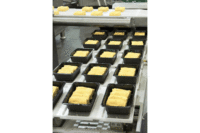
Refrigerated & Frozen Foodstalks about microwave packaging trends and technologies with Timothy Bohrer, CCP, a 35-year packaging materials expert and president of Pac Advantage Consulting, Chicago.
R&FF: What new products or packaging caught your eye last year? Why?
Bohrer: ConAgra Foods introduced Marie Callender pot pies and family-sized entrees in sophisticated field management trays that heat the product quite evenly. This is significant because it represents a family of products using this technology. Last year also saw continued growth in steamable packages and microwaveable, stand-up pouches.
R&FF: How about advances in susceptor technology?
Bohrer: Last year appeared to be a bit of a plateau for susceptor heating. There was some product consolidation in hand-held items with competition increasing in that product area. Yet there appears to be more growth on the horizon. Published patent applications suggest many companies are exploring ways aim to increase the available heat generation of a susceptor structure. I see some early introductions of new approaches in both the United States and Europe.
R&FF: So where can that technology grow?
Bohrer: Susceptor technology’s next growth spurt will come with greater heating control capabilities. I’m thinking about “hotter,” single-layer susceptor structures that duplicate or exceed a dual susceptor’s performance. New single-layer structures could offer simpler, cost-effective options.
However, the real opportunity involves using higher heat flux susceptors to extend the range of microwaveable products. High-moisture content foods – such as larger pizzas and other items that are difficult to brown and crisp – are logical targets for these technologies.
R&FF: What’s new in microwave steaming?
Bohrer: I would characterize 2011 as another year of expanded options and technology choices for microwave steaming functionality. Packagers face decisions about trade-offs of cost versus more control over the temperature/pressure at which venting is initiated. Multi-component systems offer more customization options. However, there’s increased cost compared to perforations or tortuous venting paths in seal areas.
R&FF: So what’s next in microwave steaming?
Bohrer: As the category matures, I expect to see a bit of a shake-out of various technologies. With greater experience, packagers now better understand each option’s cost/performance profiles. This means the market will trend toward preferred solutions. My personal view is that there is a growth opportunity for rigid packaging with venting lids. Flexible steaming packages prove you can gain additional sales if you simplify the consumer’s microwave heating experience.
R&FF: What should processors look for in 2012?
Bohrer: I think we’ll see continued scrutiny about how consumers achieve safe food temperatures with any microwaveable product – precooked or raw. Obviously, raw is far more difficult to manage and this seems to be a work in progress. Some experts say “no” to any consideration involving pre-packaged raw meat in the microwave. Others believe the appropriate controls can adequately reduce risk.
I think we’ll see increased emphasis on packaging technologies that effectively reduce temperature gradients (uneven temperatures) in microwaveable foods. These technologies would expand the range of microwavable foods. I’m also still waiting for substantiated, on-pack claims about microwave energy efficiency compared to conventional ovens – particularly when it comes to heating frozen foods. There’s a good story here for consumers.
